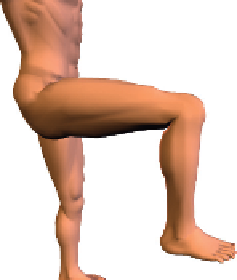Biomedical Engineering Reference
In-Depth Information
y
0
z
0
x
0
Q
y
4
11
z
4
x
4
12
FIGURE 2.24
The configuration of the lower limb as a 4-DOF model.
2.11
The Santos
s
model
Figure 2.25
illustrates Santos
s
with the kinematic model (skeleton). The values
L
i
between joints define the body parameters of the human, such as shoulder-
to-elbow distance. For generality of use of the human model, these parameters are
left as user-input and can be changed to correspond to specific anthropometrical
data. The high level of control over the distances
L
i
allows this model to represent
any anthropometrical percentile.
The z-axes in
Figure 2.25
represent the axes of rotation for each DOF (each
kinematic revolute joint). The model includes four 3-DOF spherical joints (each
modeled using three revolute joints) to represent movement of the human spine,
totaling 12 DOF for the torso segment (labeled z
0
through z
11
). Each arm includes
two revolute joints for the clavicle, a spherical joint for the shoulder, and four
additional DOF for the elbow and wrist. Hence, each arm has 9 DOF (labeled z
0
12
through z
0
20
for the right arm and z
12
through z
20
for the left). Finally, the leg seg-
ments have 7 DOF each, including a spherical joint at each hip. The result is a
segmented human kinematic model capable of representing human motion with
considerable accuracy.
2.12
Variations in anthropometry
Because the DH method is dependent upon a well-defined set of parameters, as
entered into the DH Table, it is indeed straightforward to vary these parameters
as the anthropometric model is changed.






































Search WWH ::

Custom Search